Pound sterling

Pound sterling — Ireland in this period used the British pound sterling. The pound was divided into 20 shillings and each shilling into 12 pence, making 240 pence to the pound. (The plural for "penny" is "pence", or, more informally, "pennies".)
The symbol for the shilling was "s", from the Latin solidus; that for the penny was "d", from denarius. (The solidus and denarius were Roman coins.) A mixed sum of shillings and pence such as 1 shilling and 8 pence was written as "1/8" or "1s 8d" and spoken as "one and eight". 5 shillings was written as "5s" or, commonly in price-tags, "5/–".
Coins
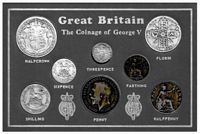
- ¼d
- farthing
- ½d
- halfpenny (ha'penny, mag, make)
- 1d
- penny (dee, copper)
- 3d
- threepence (thruppence, thruppenny bit)
- 6d
- sixpence (tanner)
- 1/–
- shilling (bob)
- 2/–
- florin (two bob)
- 2/6
- half crown
- 10s
- half sovereign
- 20s
- sovereign
Bronze
Silver

Gold
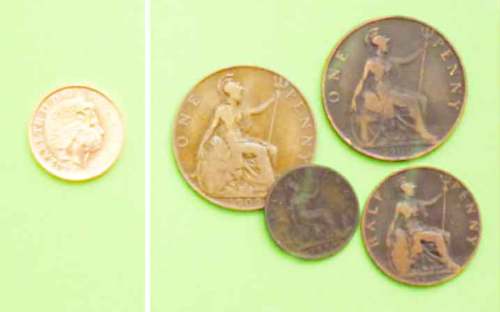
The sovereign and half sovereign were literally "worth their weight in gold". Increasingly during the Great War, they were replaced with notes.
The coins tended to be large and somewhat heavy; but as their purchasing power was high (a pint of beer in 1914 cost 2d), not too many were needed.
Notes
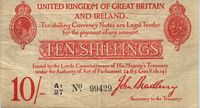 Gold grew scarce during WW1. These ten-shilling and £1 notes were issued by the Treasury (rather than by the Bank of England, as happens currently) for the purpose of removing gold from circulation – thereby hedging against hoarders and, at the same time, saving on resources.
Gold grew scarce during WW1. These ten-shilling and £1 notes were issued by the Treasury (rather than by the Bank of England, as happens currently) for the purpose of removing gold from circulation – thereby hedging against hoarders and, at the same time, saving on resources. |
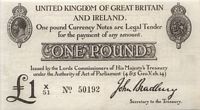 It took a while for these "Treasury notes" to be accepted as "real money". They were nicknamed Bradburys after the prominent signature of the then Treasury Secretary displayed on the face of the notes. The reverse was kept blank until the 1920s.
It took a while for these "Treasury notes" to be accepted as "real money". They were nicknamed Bradburys after the prominent signature of the then Treasury Secretary displayed on the face of the notes. The reverse was kept blank until the 1920s. |
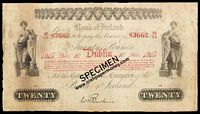 For a long time previous, banks throughout the United Kingdom, including in Ireland, had issued their own banknotes. Here's one from the Bank of Ireland, 1915.
For a long time previous, banks throughout the United Kingdom, including in Ireland, had issued their own banknotes. Here's one from the Bank of Ireland, 1915. |
Prices — calculating modern equivalents of historical sums is notoriously complicated: purchasing power (wages etc) has grown more rapidly than retail cost – that is, we can mostly afford more "things" these days. The computations that follow are taken from MeasuringWorth.com.
Something that cost £1 in 1915 would cost roundabout £62.50 in 2010 money after accounting for inflation. But its affordability, that is its relationship to average earnings, would make it equivalent to something that cost us £287.
For instance, the common 4lb loaf of bread (the "quartern") cost 8d in 1915. That makes it £2.08 in 2010 money (cheap for 4lb of bread) but in affordability it would be £9.58. A pint of beer in London in 2008 is reported as £4. In 1915 it was 3d. 3d = 78p in 2010 money, and £3.59 in affordability – remarkably similar to 1915.
Wages in Ireland at the time were famously low:
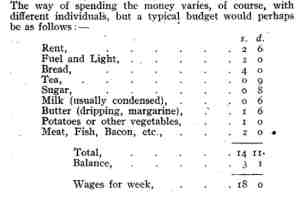
These figures compute to 2010 earnings as:
£266 (18s)
£591 (40s)
At the time "22 shillings per week was considered the barest minimum to maintain 'merely physical efficiency'". Bearing in mind that a third of Dublin workers were in fact casual labourers, it can be seen that there wasn't very much money, if any at all, to spare.
Links
Wikipedia: Pound sterlingWikipedia: Coins of Pound sterling
Tony Clayton's Coins of England and Great Britain
Money and Coinage in Victorian Britain
Join me in the 1900s – coins
Relative Value of Sums of Money
MeasuringWorth.com